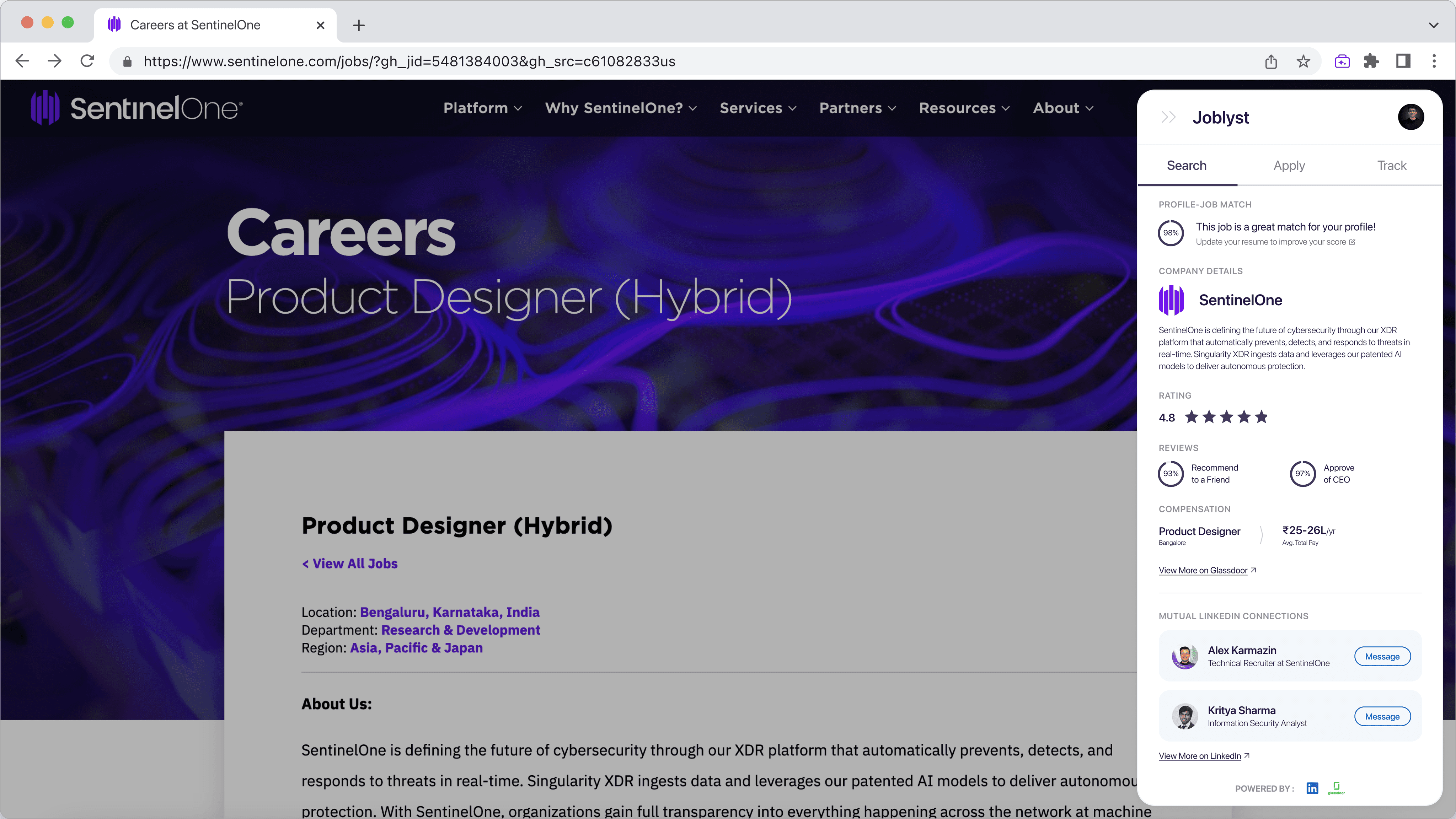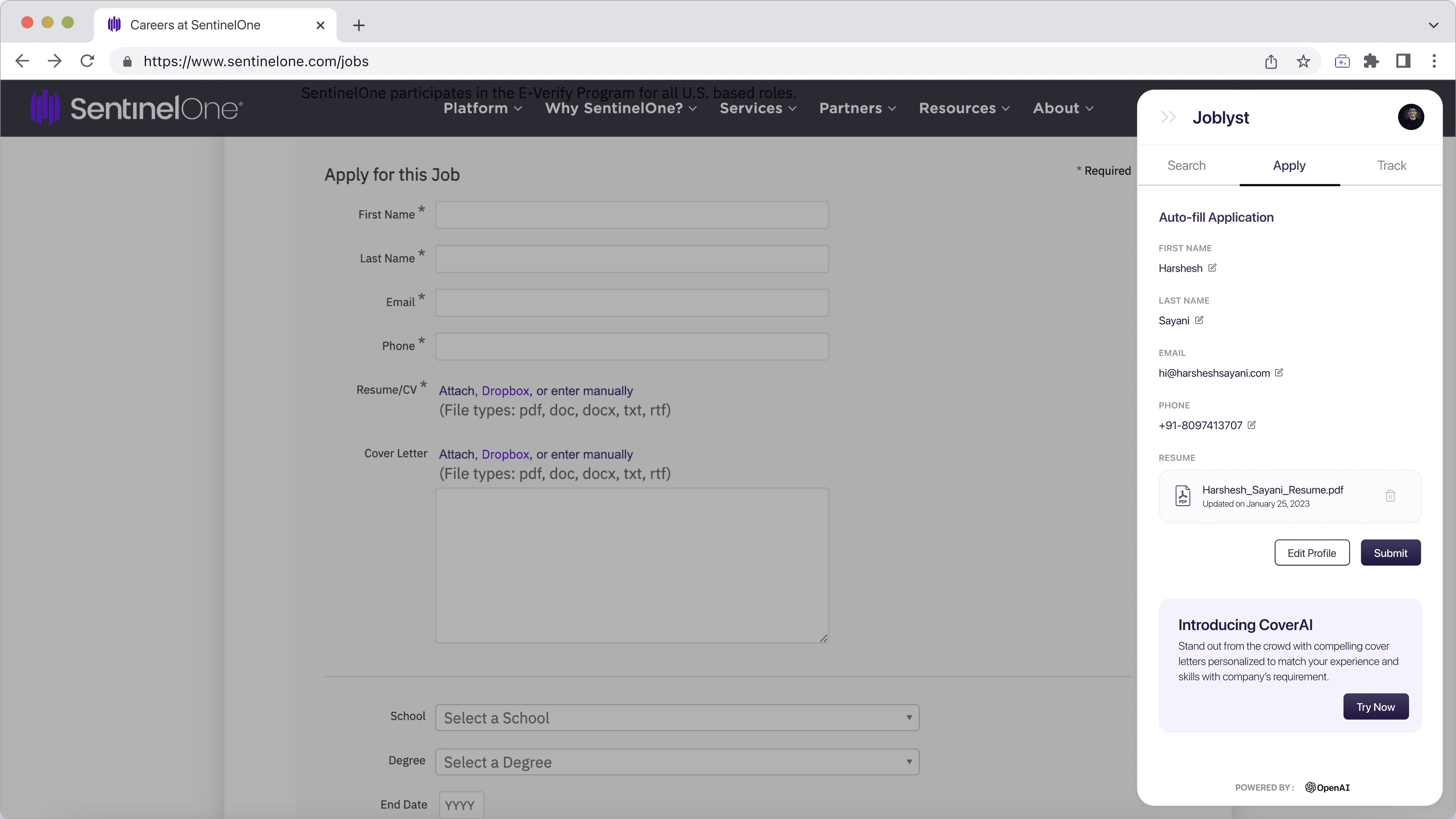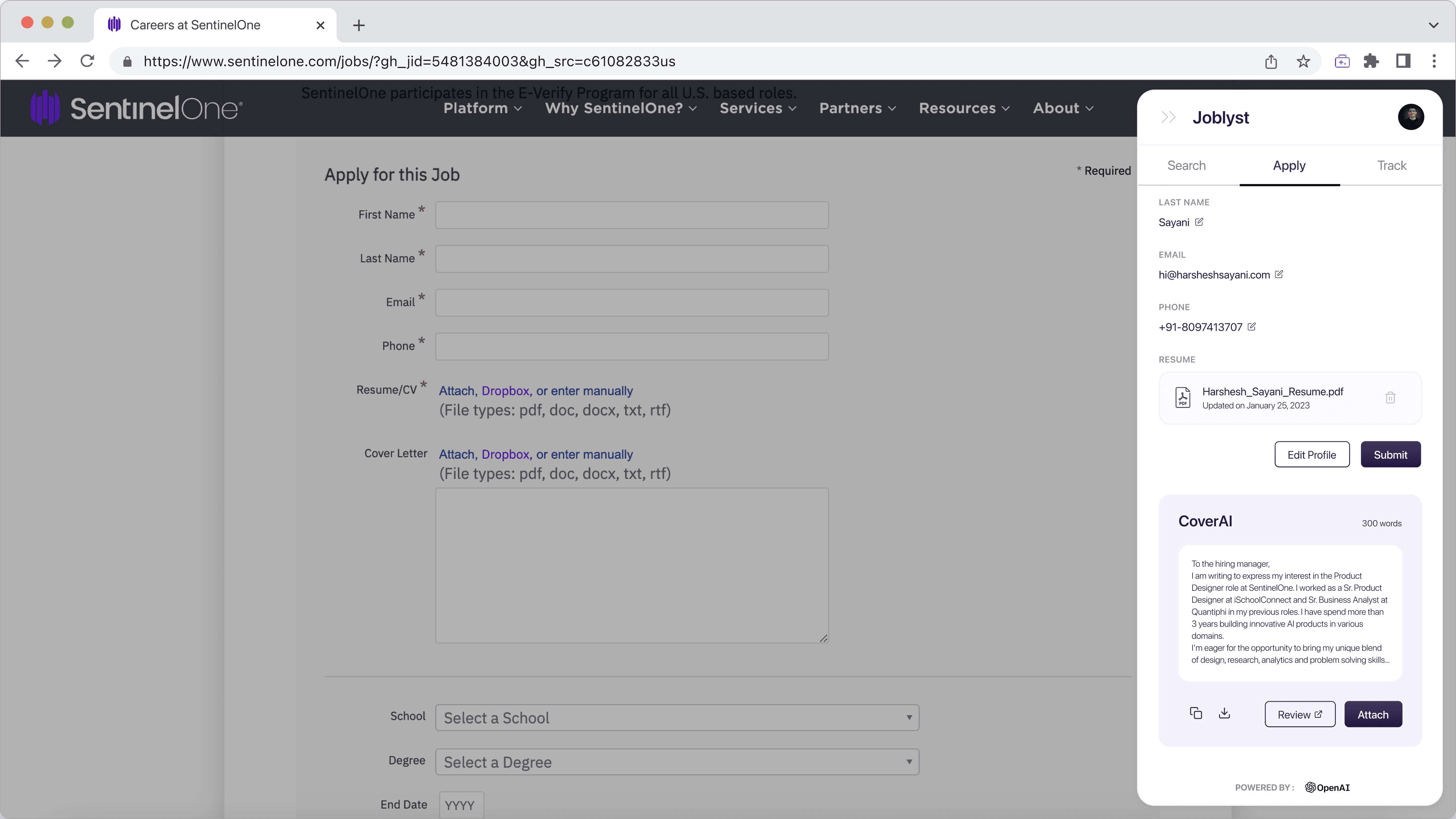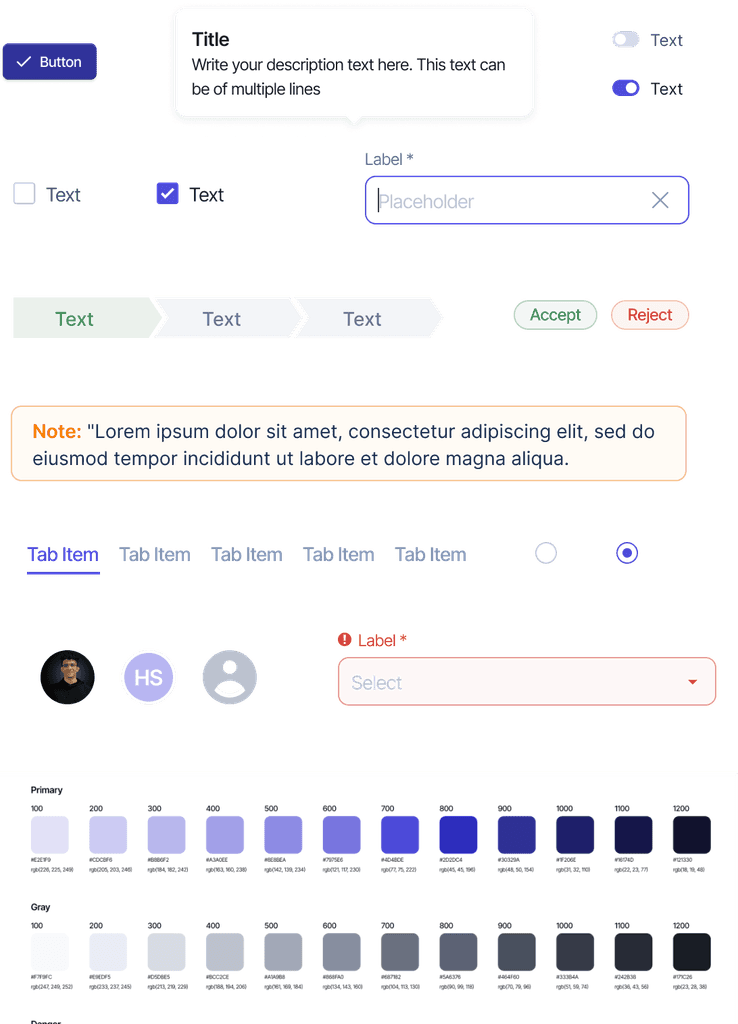Joblyst
Joblyst
Joblyst



TL;DR
What did I do?
Designed a web application aimed at assisting job seekers throughout their entire journey. Initially, the project began as a design challenge focusing on the creation of a browser extension. However, after conducting extensive user research, it became apparent that a web application was necessary to handle more intricate interactions in conjunction with the extension.
What did I learn?
I learned the significance of iteration and the substantial impact that primary research and testing have on the design process.
Short Recap of Iteration 1
I created a Chrome Extension that provided users with organization and job role insights, streamlined the application process by autofilling forms, and enabled custom cover letter attachments. Iteration 1 primarily involved secondary research, wireframing and rapid prototyping.
What was the need of Iteration 2?
Shortly after personally encountering user frustrations while applying for internships during my Master's in HCI/D, I recognized that the extension fell short. The job and internship search is a multifaceted process, requiring ongoing monitoring and organization. While the Joblyst extension provided valuable features such as Company Details and Application Auto-fill, Application Tracking and Document Management still consumed a substantial amount of users' time.
How might we enhance the job search experience for students while minimizing the time and effort they need to invest?
Research
User Interviews
I conducted 10 user interviews, consisting of 6 in-person and 4 virtual sessions, aimed at gaining insights into their usual job search and application procedures.

Contextual Inquiry
I also conducted observations with 2 individuals as they navigated their application processes. During these sessions, I asked them questions and guided them through specific tasks, such as, “if this company required a cover letter, how would you go about uploading it?”
Secondary Research
A 2020 study by the National Association of Colleges and Employers (NACE) found that 61% of graduate students reported spending between 1 and 15 hours per week on job search activities, and 28% reported spending more than 15 hours per week on job search activities. The average amount of time spent on job search activities was 15 hours per week.
Reference: https://www.naceweb.org/job-market/graduate-outcomes/first-destination
Key Takeaways from Research

A participant shared the Google Sheet they used to track their previous year's internship search process.

Creating customized cover letters for every other company and managing these documents was time consuming and messy.
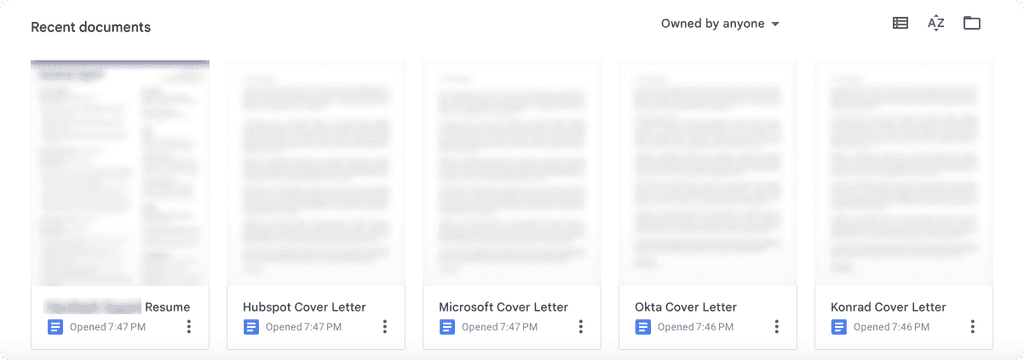
Information Architecture
Informed by the research findings, I created an Information Architecture -
Prototyping
Onboarding
Given that email is the primary mode of communication, we request user permission to scan their emails solely for specific keywords and from designated email addresses. Privacy concerns may arise for some users, making it essential to effectively convey the importance of this onboarding process through our screens.
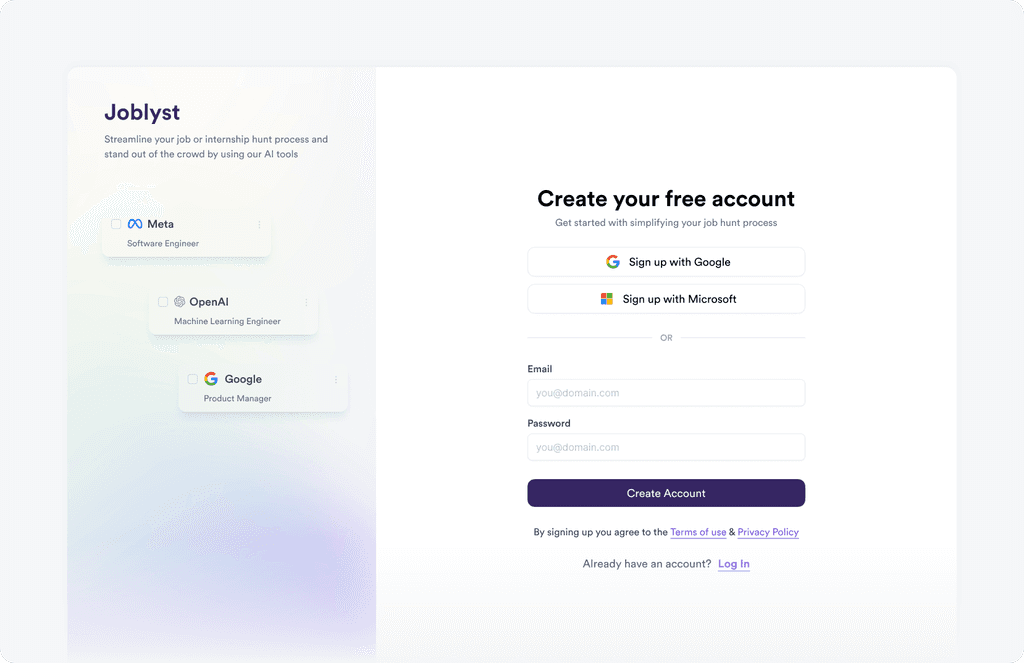
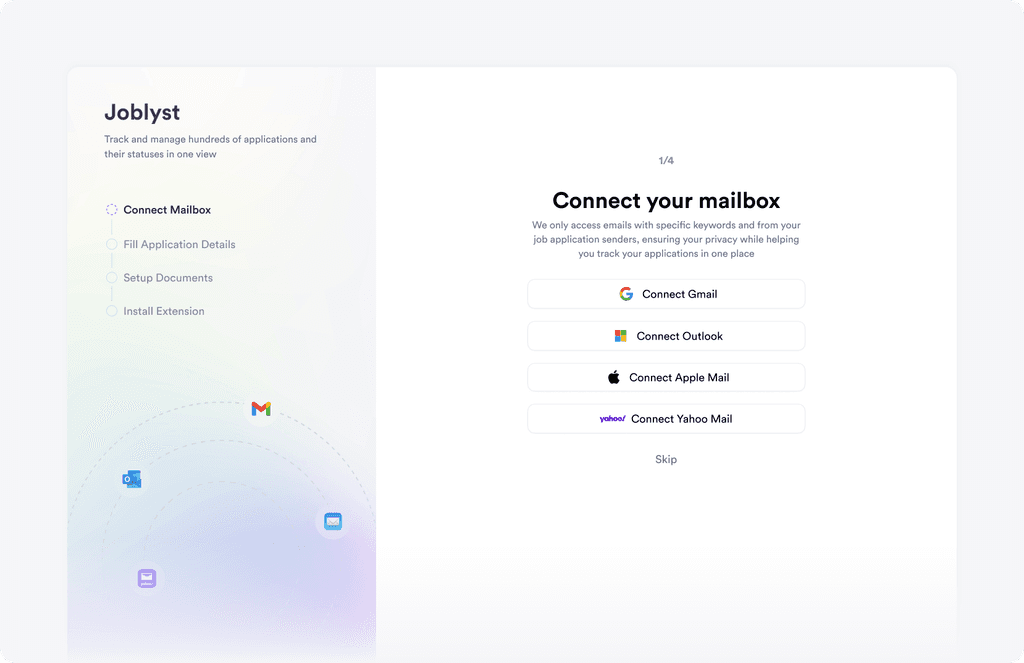
Home
To provide an overview of the entire application process.

Documents
Generating customized resumes and cover letters for hundreds of companies while managing these documents was overwhelming. In the initial solution for the Extension, I integrated OpenAI's GPT API to create personalized resumes and cover letters. It's crucial to adapt these documents to match the job descriptions while retaining the user's unique background. The master documents serve as the basis for generating tailored content for individual companies.

Jobs
Job searching and curation are time-consuming, and popular job search tools often lack essential filters, such as visa sponsorship information.
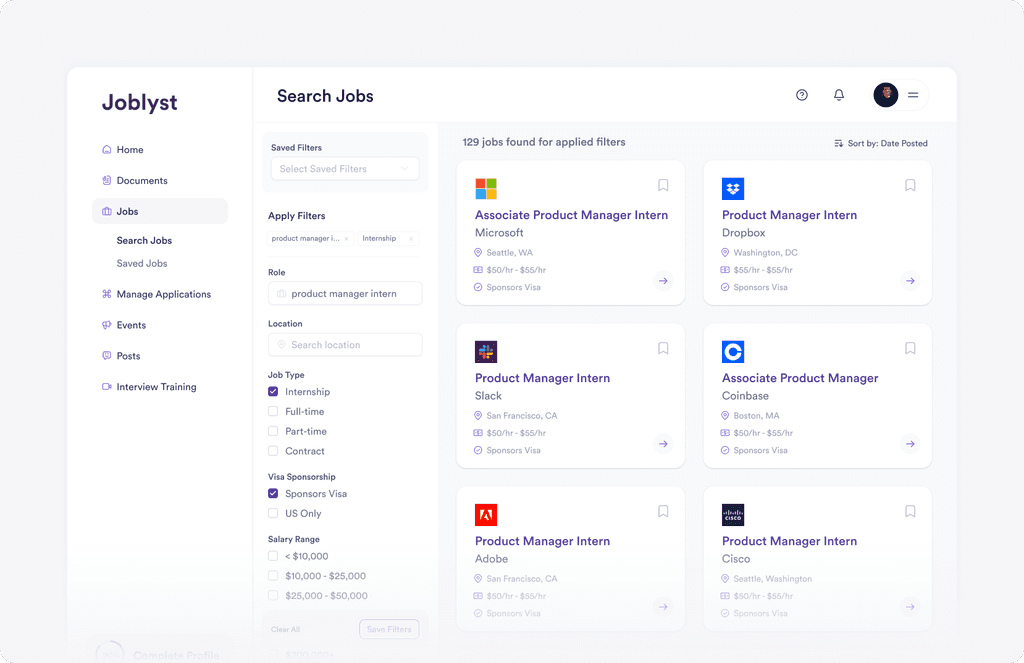
Manage Applications
Managing hundreds of job applications is a challenging task. According to our research, some users resort to spreadsheets, while others don't bother tracking at all. This poses a significant issue – for instance, you might have applied to Walmart through the Workday portal and missed a critical task related to US work authorization due to the sheer volume of applications.

The Kanban view empowers users to effortlessly drag and drop their applications into various statuses.
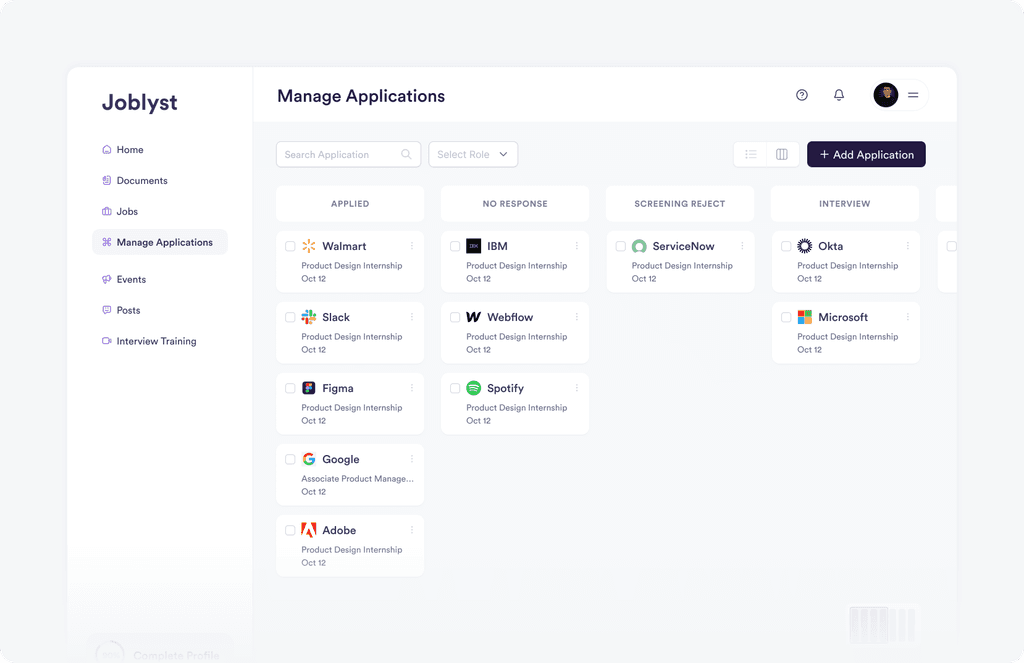
Events
Career Fairs and Networking events are crucial in a user's journey, whether in person or online. Users often find these events through various platforms such as Handshake, LinkedIn, and university emails. It was essential to centralize and provide users with the capability to register for these events and receive reminders through notifications and email.
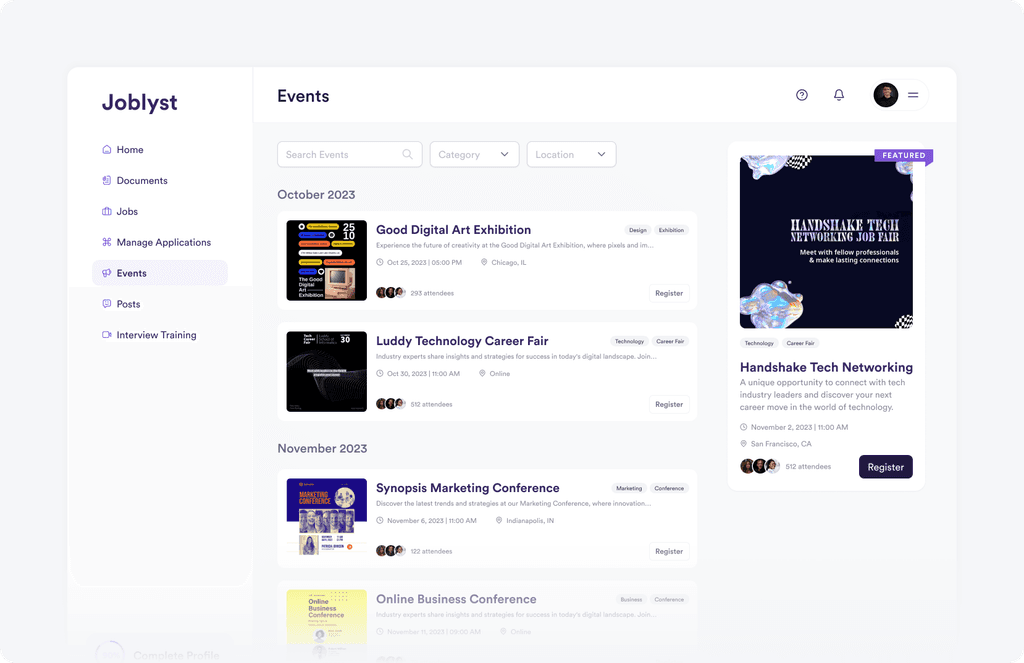
Testing
Cognitive Walkthrough
Conducted a Cognitive Walkthrough with a few of my HCI classmates, all of whom are experienced UX Designers.

Key Insight: Was the Home screen necessary, and if so, was it essential for it to be the initial screen displayed? There's a possibility that it could lead to anxiety when users view the summary card.
Usability Testing
Following the integration of insights from the Cognitive Walkthrough, I conducted usability testing with a potential user who had no prior UX knowledge.
TL;DR
What did I do?
Designed a web application aimed at assisting job seekers throughout their entire journey. Initially, the project began as a design challenge focusing on the creation of a browser extension. However, after conducting extensive user research, it became apparent that a web application was necessary to handle more intricate interactions in conjunction with the extension.
What did I learn?
I learned the significance of iteration and the substantial impact that primary research and testing have on the design process.
Short Recap of Iteration 1
I created a Chrome Extension that provided users with organization and job role insights, streamlined the application process by autofilling forms, and enabled custom cover letter attachments. Iteration 1 primarily involved secondary research, wireframing and rapid prototyping.
What was the need of Iteration 2?
Shortly after personally encountering user frustrations while applying for internships during my Master's in HCI/D, I recognized that the extension fell short. The job and internship search is a multifaceted process, requiring ongoing monitoring and organization. While the Joblyst extension provided valuable features such as Company Details and Application Auto-fill, Application Tracking and Document Management still consumed a substantial amount of users' time.
How might we enhance the job search experience for students while minimizing the time and effort they need to invest?
Research
User Interviews
I conducted 10 user interviews, consisting of 6 in-person and 4 virtual sessions, aimed at gaining insights into their usual job search and application procedures.

Contextual Inquiry
I also conducted observations with 2 individuals as they navigated their application processes. During these sessions, I asked them questions and guided them through specific tasks, such as, “if this company required a cover letter, how would you go about uploading it?”
Secondary Research
A 2020 study by the National Association of Colleges and Employers (NACE) found that 61% of graduate students reported spending between 1 and 15 hours per week on job search activities, and 28% reported spending more than 15 hours per week on job search activities. The average amount of time spent on job search activities was 15 hours per week.
Reference: https://www.naceweb.org/job-market/graduate-outcomes/first-destination
Key Takeaways from Research

A participant shared the Google Sheet they used to track their previous year's internship search process.

Creating customized cover letters for every other company and managing these documents was time consuming and messy.

Information Architecture
Informed by the research findings, I created an Information Architecture -
Prototyping
Onboarding
Given that email is the primary mode of communication, we request user permission to scan their emails solely for specific keywords and from designated email addresses. Privacy concerns may arise for some users, making it essential to effectively convey the importance of this onboarding process through our screens.


Home
To provide an overview of the entire application process.

Documents
Generating customized resumes and cover letters for hundreds of companies while managing these documents was overwhelming. In the initial solution for the Extension, I integrated OpenAI's GPT API to create personalized resumes and cover letters. It's crucial to adapt these documents to match the job descriptions while retaining the user's unique background. The master documents serve as the basis for generating tailored content for individual companies.

Jobs
Job searching and curation are time-consuming, and popular job search tools often lack essential filters, such as visa sponsorship information.

Manage Applications
Managing hundreds of job applications is a challenging task. According to our research, some users resort to spreadsheets, while others don't bother tracking at all. This poses a significant issue – for instance, you might have applied to Walmart through the Workday portal and missed a critical task related to US work authorization due to the sheer volume of applications.

The Kanban view empowers users to effortlessly drag and drop their applications into various statuses.

Events
Career Fairs and Networking events are crucial in a user's journey, whether in person or online. Users often find these events through various platforms such as Handshake, LinkedIn, and university emails. It was essential to centralize and provide users with the capability to register for these events and receive reminders through notifications and email.

Testing
Cognitive Walkthrough
Conducted a Cognitive Walkthrough with a few of my HCI classmates, all of whom are experienced UX Designers.

Key Insight: Was the Home screen necessary, and if so, was it essential for it to be the initial screen displayed? There's a possibility that it could lead to anxiety when users view the summary card.
Usability Testing
Following the integration of insights from the Cognitive Walkthrough, I conducted usability testing with a potential user who had no prior UX knowledge.
TL;DR
What did I do?
Designed a web application aimed at assisting job seekers throughout their entire journey. Initially, the project began as a design challenge focusing on the creation of a browser extension. However, after conducting extensive user research, it became apparent that a web application was necessary to handle more intricate interactions in conjunction with the extension.
What did I learn?
I learned the significance of iteration and the substantial impact that primary research and testing have on the design process.
Short Recap of Iteration 1
I created a Chrome Extension that provided users with organization and job role insights, streamlined the application process by autofilling forms, and enabled custom cover letter attachments. Iteration 1 primarily involved secondary research, wireframing and rapid prototyping.
What was the need of Iteration 2?
Shortly after personally encountering user frustrations while applying for internships during my Master's in HCI/D, I recognized that the extension fell short. The job and internship search is a multifaceted process, requiring ongoing monitoring and organization. While the Joblyst extension provided valuable features such as Company Details and Application Auto-fill, Application Tracking and Document Management still consumed a substantial amount of users' time.
How might we enhance the job search experience for students while minimizing the time and effort they need to invest?
Research
User Interviews
I conducted 10 user interviews, consisting of 6 in-person and 4 virtual sessions, aimed at gaining insights into their usual job search and application procedures.

Contextual Inquiry
I also conducted observations with 2 individuals as they navigated their application processes. During these sessions, I asked them questions and guided them through specific tasks, such as, “if this company required a cover letter, how would you go about uploading it?”
Secondary Research
A 2020 study by the National Association of Colleges and Employers (NACE) found that 61% of graduate students reported spending between 1 and 15 hours per week on job search activities, and 28% reported spending more than 15 hours per week on job search activities. The average amount of time spent on job search activities was 15 hours per week.
Reference: https://www.naceweb.org/job-market/graduate-outcomes/first-destination
Key Takeaways from Research

A participant shared the Google Sheet they used to track their previous year's internship search process.

Creating customized cover letters for every other company and managing these documents was time consuming and messy.

Information Architecture
Informed by the research findings, I created an Information Architecture -
Prototyping
Onboarding
Given that email is the primary mode of communication, we request user permission to scan their emails solely for specific keywords and from designated email addresses. Privacy concerns may arise for some users, making it essential to effectively convey the importance of this onboarding process through our screens.


Home
To provide an overview of the entire application process.

Documents
Generating customized resumes and cover letters for hundreds of companies while managing these documents was overwhelming. In the initial solution for the Extension, I integrated OpenAI's GPT API to create personalized resumes and cover letters. It's crucial to adapt these documents to match the job descriptions while retaining the user's unique background. The master documents serve as the basis for generating tailored content for individual companies.

Jobs
Job searching and curation are time-consuming, and popular job search tools often lack essential filters, such as visa sponsorship information.

Manage Applications
Managing hundreds of job applications is a challenging task. According to our research, some users resort to spreadsheets, while others don't bother tracking at all. This poses a significant issue – for instance, you might have applied to Walmart through the Workday portal and missed a critical task related to US work authorization due to the sheer volume of applications.

The Kanban view empowers users to effortlessly drag and drop their applications into various statuses.

Events
Career Fairs and Networking events are crucial in a user's journey, whether in person or online. Users often find these events through various platforms such as Handshake, LinkedIn, and university emails. It was essential to centralize and provide users with the capability to register for these events and receive reminders through notifications and email.

Testing
Cognitive Walkthrough
Conducted a Cognitive Walkthrough with a few of my HCI classmates, all of whom are experienced UX Designers.

Key Insight: Was the Home screen necessary, and if so, was it essential for it to be the initial screen displayed? There's a possibility that it could lead to anxiety when users view the summary card.
Usability Testing
Following the integration of insights from the Cognitive Walkthrough, I conducted usability testing with a potential user who had no prior UX knowledge.
Other Work

Live
iSchoolConnect
Designed and improved the experience of multiple Ed-tech products
Thank you for visiting!
© 2023 Harshesh Sayani. All Rights Reserved.
